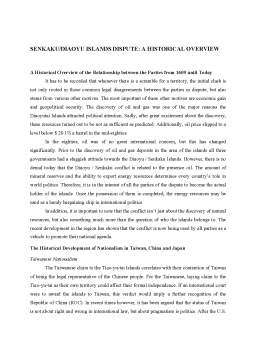Extras din referat
A Historical Overview of the Relationship between the Parties from 1609 until Today
It has to be recorded that whenever there is a scramble for a territory, the initial clash is not only rooted in those common legal disagreements between the parties in dispute, but also stems from various other motives. The most important of these other motives are economic gain and geopolitical security. The discovery of oil and gas was one of the major reasons the Diaoyutai Islands attracted political attention. Sadly, after great excitement about the discovery, these resources turned out to be not as sufficient as predicted. Additionally, oil price slipped to a level below $ 20 US a barrel in the mid-eighties.
In the eighties, oil was of no great international concern, but this has changed significantly. Prior to the discovery of oil and gas deposits in the area of the islands all three governments had a sluggish attitude towards the Diaoyu / Senkaku Islands. However, there is no denial today that the Diaoyu / Senkaku conflict is related to the presence oil. The amount of mineral reserves and the ability to export energy resources determines every country’s role in world politics. Therefore, it is in the interest of all the parties of the dispute to become the actual holder of the islands. Once the possession of them is completed, the energy resources may be used as a handy bargaining chip in international politics.
In addition, it is important to note that the conflict isn’t just about the discovery of natural resources, but also something much more than the question of who the islands belongs to. The recent development in the region has shown that the conflict is now being used by all parties as a vehicle to promote their national agenda.
The Historical Development of Nationalism in Taiwan, China and Japan
Taiwanese Nationalism
The Taiwanese claim to the Tiao-yu-tai Islands correlates with their contention of Taiwan of being the legal representative of the Chinese people. For the Taiwanese, laying claim to the Tiao-yu-tai as their own territory could affect their formal independence. If an international court were to award the islands to Taiwan, this verdict would imply a further recognition of the Republic of China (ROC). In recent times however, it has been argued that the status of Taiwan is not about right and wrong in international law, but about pragmatism is politics. After the U.S. modified their China policy in 1971-72 Taiwan lost its seat in the United Nations. Today, Taiwan maintains diplomatic relations with only 25 countries and thus receives little international recognition. This recognition is mainly based on a “dollar diplomacy”, a policy whereby Taiwan buys diplomatic relations. Only 48 countries have established representative offices in Taipei. Legally speaking, Taiwan is today a self-governing dominion under the benign of the military occupier USA. Against this backdrop, you may agree with me that a Taiwanese nation does not yet fully exist. The President regularly hints at a declaration of independence, which causes severe threats from China mainland. Taking into account the common standards to be applied for probing the independence of a state (such as territory, population, government, capacity to enter in relation with other states) it must be concluded that Taiwan is not legally an independent state and “owns” only de-facto Taiwan and some offshore islands. Interestingly, Taiwan has not yet claimed its own statehood (declaration of independence) and declared that it would actually secede from China. In 1991, the ROC recognized mainland China authorities as a “political entity”. Although being aware of their common roots with the Chinese mainland, today more and more Taiwanese consider themselves as Taiwanese rather than Chinese.
The two Chinas do not grant international recognition to each other. Dealing with Taiwan, the Chinese press continuously refers to the Taiwan as the “Taiwan province” to make clear that they regard the ROC as a renegade island belonging to mainland China. As a result, a peaceful settlement of the Diaoyu question with participation of the ROC and the PRC has to be ruled out until the Taiwan question is finally resolved.
Bibliografie
- The dispute in the South Chinese Sea, Bob Catley and Makmur Keliat, Spratlys, 1987
- Umstrittene Seerechtsgebiete on Ost- und Südostasien, Werner Draghun, 1985
- Diayutai islands dispute, Cheng Huang, June 1997
- The Right to Participate inthe United Nations, Sheng-tsung Yang in The International Status of Taiwan in the New World Order, 1996
- Nationalism in East Asia, Shiraishi Takashi, 2004
- A Short History of Taiwan- A Case for Independence, Gary Marvin Davison, 2003
- Nationalism, Internationalism and Chinese Foreign Policy, Chen Zhimin, Vol. 14 Journal of Contemporary China
- China’s Marine Legal System and the Law of the Sea, Zou Keyuan, 2005
- China’s Calculus of Japan’s Asian Policy, Jianwei Wang in Takahashi Inoguchi (ed.), Japan’s Asian Policy, 2002
- China, Vietnam und die Gebietsansprüche im chinesischen Meer, Hans Scheerer, Patrick Raszelenberg, 2002
- The Future of U.S.-China Relations, Aaron L. Friedberg, Vol. 30 International Security, 2005
- Public Diplomacy in the People’s Republic of China, Ingrid d’Hooghe, 2004
- China’s Security Interests in the 21rst Century, Russell Org, 2007
- History and an analysis of the ownership Claims of The P.R.C., R.O.C. and Japan, Han-yi Shaw, No. 3, 1999
- The Territorial Sovereignty over the Senkaku Islands and Problems on the Surrounding
- Continental Shelf, Toshio Okuhara, Vol. 11 Japan Annual of International Law, 1967
- The Sino-Japanese Dispute Over the Tiao-yu-tai (Senkaku) Islands and the Law of Territorial Acquisition, Tao Cheng, “”, Vol.14 V.J.I.L, 1973
- www.duei.de/ifa/shop/pdf/mia387-Schucher-Inhalt.pdf
- www.gio.gov.tw/ct.asp?xItem=18852&ctNode=2587&&mp=807
- www.taiwankey.net/dc/hartzell5.pdf
- www.geocities.com/nankingatrocities/Fall/fall_01.htm
- www.time.com/time/printout//0,8816,501040315-598584,00.html;
- www.dur.ac.uk/chinesepolitics/Public%20lectures/wu%20Zhengyu%20Durham%20Lectures.pdf
- www.pinr.com/report.php?ac=view_printable&report_id=165&language_id=1
- www.ism.ac.jp/~cuturi/misc/japan_chine.pdf.
Preview document
Conținut arhivă zip
- Senkaku-Diaoyu islands dispute - a historical overview.docx










